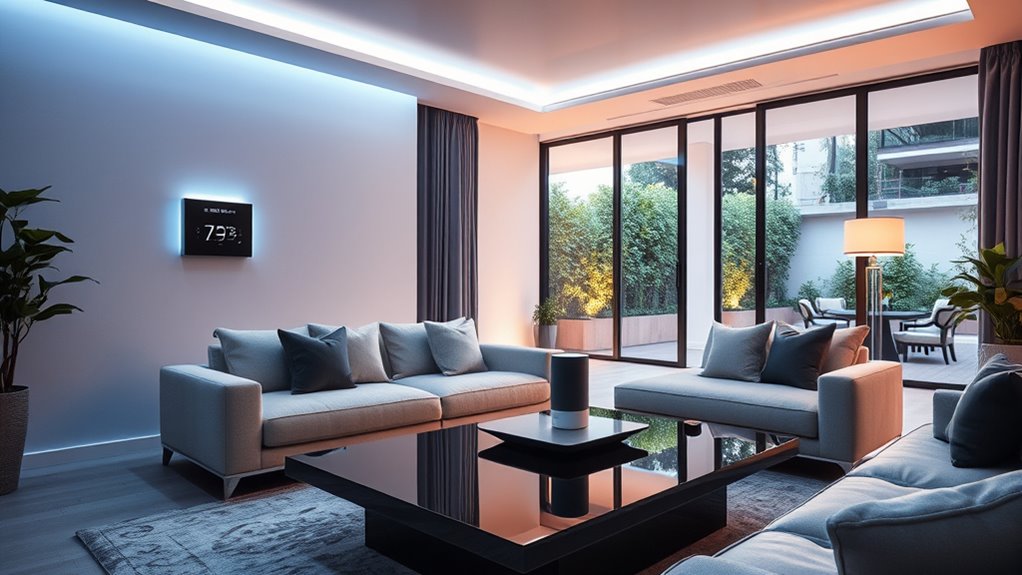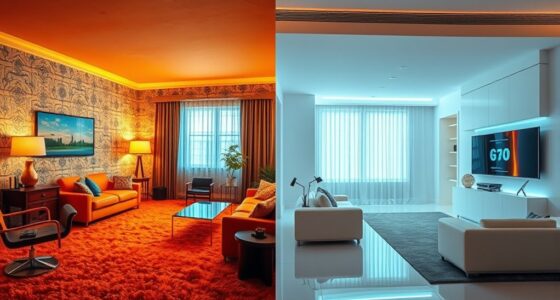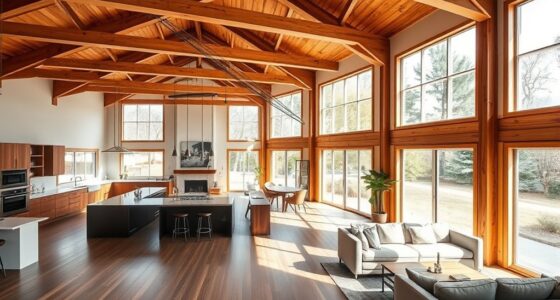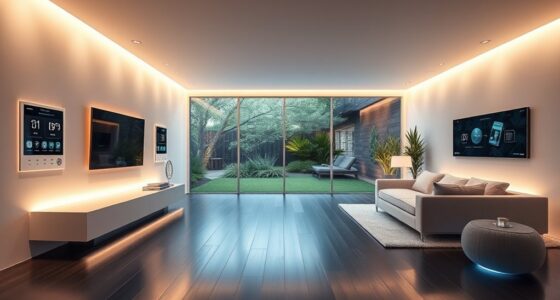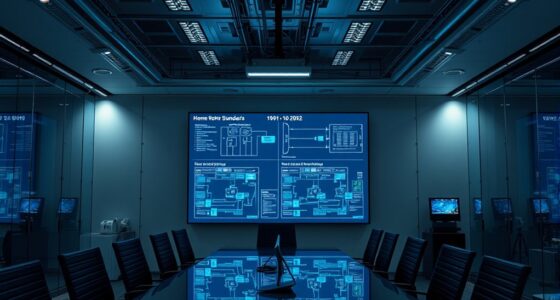Smart home innovations are transforming how you live, from luxury villas to everyday apartments. Voice control systems let you manage lighting, climate, and security effortlessly with simple commands. Automation enhances convenience, energy efficiency, and sustainability by reducing waste and optimizing utilities. These smart features create comfortable, adaptive spaces that respond to your routines, even when you’re away. Keep exploring to discover how these advancements can make your home smarter and more personalized.
Key Takeaways
- Voice control systems enable seamless management of home functions, from lighting to climate, in both luxury villas and standard apartments.
- Automation features enhance daily routines, making home living more effortless and accessible for all users.
- Smart home technologies improve energy efficiency through automated adjustments and real-time monitoring, reducing utility costs.
- Continuous innovations integrate utilities like thermostats and lighting for adaptive, responsive living environments.
- Remote management capabilities allow homeowners to control and monitor their homes conveniently from anywhere.

Have you ever wondered how smart home innovations are transforming the way you live? Today’s technology makes it easier than ever to control your environment with just your voice. Voice control systems, like smart speakers and virtual assistants, allow you to manage lighting, adjust the thermostat, lock doors, and even play your favorite music without lifting a finger. Imagine waking up and saying, “Good morning,” and having your blinds open, coffee brewing in the kitchen, and the room temperature set just right. It’s a seamless way to start your day, and it’s becoming a standard feature in many homes, whether luxury villas or everyday apartments.
Smart home voice controls make daily routines seamless and effortless.
Beyond convenience, voice control plays a significant role in increasing your home’s energy efficiency. When you can effortlessly turn off unused lights, adjust the thermostat, or shut down appliances with a simple command, you reduce unnecessary energy consumption. This not only helps lower your utility bills but also contributes to a more sustainable lifestyle. Smart home systems can learn your routines over time, automatically adjusting settings to optimize energy use. For instance, they might lower the heating or cooling when you’re not home or turn off devices that are left on unintentionally. This automation guarantees you’re not wasting energy, making your home smarter and greener.
Smart technology also enables you to monitor and manage energy consumption in real time. Many systems provide detailed reports on how much energy each device uses, giving you insights to make more informed decisions. You can set schedules for appliances, ensuring they run only when needed, or receive alerts if something’s using more power than usual. This level of control helps you reduce your carbon footprint while saving money. The integration of voice control with energy management creates a user-friendly experience, where you don’t need to navigate complex menus or apps to keep your home efficient. Instead, a simple voice command can activate or deactivate multiple systems at once.
As smart home innovations continue to evolve, they’re making everyday living more convenient, comfortable, and eco-friendly. The combination of voice control and energy efficiency isn’t just about high-tech gadgets—it’s about transforming your home into a space that adapts to your needs effortlessly. Whether you’re relaxing in your living room, working from home, or away on vacation, these smart features work behind the scenes to enhance your lifestyle. They allow you to enjoy the benefits of advanced technology without sacrificing simplicity, creating a home environment that’s more responsive, efficient, and personalized than ever before. Additionally, smart utilities such as smart thermostats and lighting systems significantly contribute to this energy-conscious approach, making your home more sustainable.
Frequently Asked Questions
How Secure Are Smart Home Devices Against Hacking?
Smart home devices can be vulnerable to hacking due to cybersecurity risks, but you can enhance their security. Regularly update your device firmware, use strong, unique passwords, and enable two-factor authentication when available. Be aware of privacy concerns, and avoid connecting devices to unsecured networks. While no system is completely foolproof, taking these steps considerably reduces your risk of hacking and helps protect your personal data.
What Is the Average Cost of Implementing Smart Home Systems?
The average cost of implementing smart home systems ranges from $1,500 to $10,000, depending on your setup. Your cost breakdown includes devices like smart thermostats, security cameras, and lighting, plus installation expenses. If you choose professional installation, expect higher costs, but it can guarantee everything works seamlessly. DIY options are cheaper but might require more time and technical skills. Overall, plan accordingly based on your budget and desired features.
Can Smart Home Technology Be Easily Upgraded Over Time?
Yes, you can easily upgrade your smart home technology over time. Most systems receive software updates that add features and improve security, making upgrades simple and seamless. However, hardware compatibility is key; verify new devices are compatible with your existing setup. You might need to replace some components, but overall, smart home tech is designed for easy upgrades, helping you stay current without complete overhauls.
How Energy-Efficient Are These Smart Home Innovations?
Smart home innovations are generally quite energy-efficient, helping you reduce energy consumption and lower utility bills. By automating lighting, heating, and cooling systems, you minimize waste and optimize usage, which positively impacts the environment. These technologies often include features to monitor and manage energy use, making it easier for you to make eco-friendly choices and decrease your overall environmental impact. Overall, they promote smarter, greener living.
Are Smart Home Devices Compatible With Existing Home Setups?
Yes, smart home devices are generally compatible with existing setups, but you might face retrofit challenges. Many devices now support standard protocols like Zigbee or Z-Wave, easing interoperability. However, integrating new gadgets with older systems can sometimes require additional hubs or adapters. To guarantee smooth operation, check compatibility beforehand, and be prepared for potential retrofit challenges that could involve updating or replacing certain components for seamless device interoperability.
Conclusion
Smart home innovations seamlessly blend luxury and everyday living, making your space smarter, safer, and more satisfying. As technology transforms your home into a hub of convenience, remember that small steps lead to significant strides. Embrace these advancements, empower your environment, and enjoy the effortless elegance they bring. With wise upgrades and witty implementations, you’ll wonder why you waited. Ultimately, smart home solutions turn your house into a haven of happiness and harmony.
